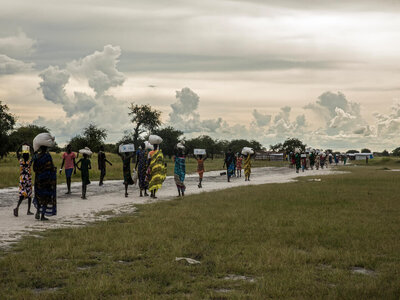برامج الطوارئ والانتقال
- 9 سنوات
- هو متوسط مدة حالة الطوارئ الإنسانية
- أكثر من 60%
- من إجمالي إنفاق برنامج الأغذية العالمي يذهب إلى برامج الطوارئ
- 83 مليون شخص
- تم الوصول إليهم بمساعدات طارئة في 2020، بزيادة قدرها 36% مقارنة بعام 2019
إن العمل الإنساني أصبح متعدد المستويات ومعقدًا بشكل متزايد، مع مزيج من الصراع والأحداث المناخية المتكررة التي تؤثر في معظم الأزمات الإنسانية. ويستدعي هذا الطلب على برنامج الأغذية العالمي من المنظمة أن تفهم بشكل حاسم السياقات التشغيلية للأماكن التي نعمل فيها، وأن تضمن أن تكون أصوات أولئك الذين نخدمهم في قلب كل ما نقوم به.
يضمن فريق الطوارئ والانتقالات لدينا في المقر الرئيسي أن مكاتب برنامج الأغذية العالمي القطرية لديها السياسات والتوجيهات والأدوات والتدريب المناسب لإطلاق البرامج التي تلبي احتياجات أولئك الذين نخدمهم.
إن عمليات برنامج الأغذية العالمي في حالات الطوارئ وحالات الطوارئ المطولة هي جوهر عمل المنظمة. في هذه السياقات، غالبًا ما يعوق الصراع وعدم المساواة بين الجنسين والاستبعاد الوصول إلى الغذاء وقدرة الناس على تلبية احتياجاتهم الغذائية وغيرها من الاحتياجات الأساسية.
إن اتباع نهج حساس للصراع في تصميم البرامج والعمليات وتنفيذها أمر بالغ الأهمية. يدعم نهج برنامج الأغذية العالمي برامج أكثر فعالية معتمدة على الأدلة والبراهين، مما يضمن أن توفر استجابته بيئة وقائية للمستفيدين مع معالجة المخاطر التي يتعرضون لها ومتطلباتهم الفريدة. كما نركز بشكل كبير على المساءلة أمام الأشخاص الذين نخدمهم.
يركز برنامج الأغذية العالمي على معالجة المخاطر التي يتعرض لها السكان المتضررون ودمج هذا الفهم في دورة برمجته وعمله اليومي. هذا يساعد مكاتبنا القُطرية على أن تكون أكثر تركيزًا على الناس وأكثر خضوعًا للمساءلة أمام الأشخاص الذين يحتاجون إلى دعمنا.
نحن نعطي الأولوية لاستهداف المستفيدين وإعطائهم الأولوية، وإشراك المجتمع وأنظمة إبداء الرأي، ومراقبة كيفية تقليل برنامج الأغذية العالمي للمخاطر التي يتعرض لها السكان وزيادة الوصول إلى الغذاء. بالإضافة إلى الشراكات مع المنظمات والمؤسسات المحلية، يسعى برنامج الأغذية العالمي إلى إقامة تحالفات مع المنظمات التي لديها مهارات في رصد الحماية وتحليل الصراعات والبرمجة الحساسة للصراعات. علاوة على ذلك، يمكن للشركاء ذوي المهارات في مفاوضات الوصول دعم المكاتب القطرية في اتخاذ خيارات أكثر استنارة في كيفية تصميم برامج المساعدات الغذائية وتقديمها.
Key areas of emergency and transition programming
-
Accountability to affected populations
-
WFP is first and foremost accountable to the people we serve, and in order to do this, we must ensure that the decision-making process is meaningful and engaging. This means people receiving appropriate and prompt information, so they can make informed decisions and have access to multiple safe and effective mechanisms to provide feedback. This in turn means that WFP can continuously adapt its programming.
-
Protection
-
Conflict and hunger
-
Humanitarian principles and access
-
Programming in urban settings
-
Population displacement

